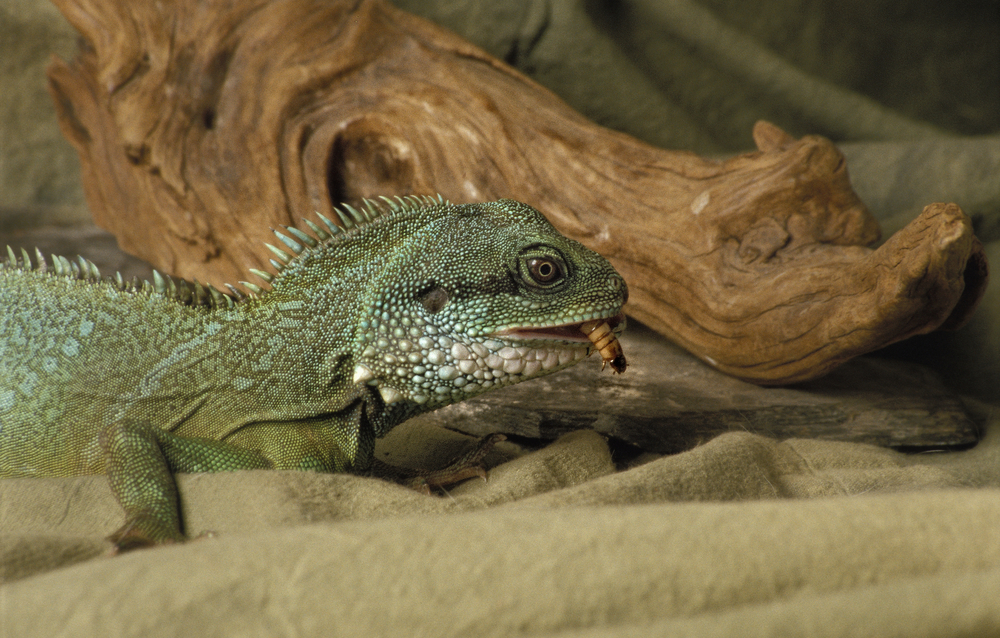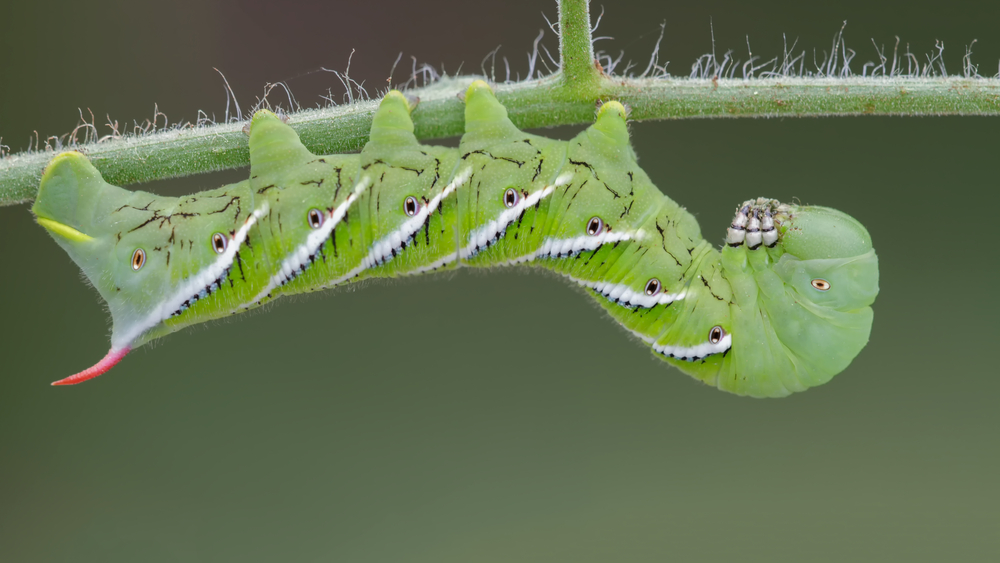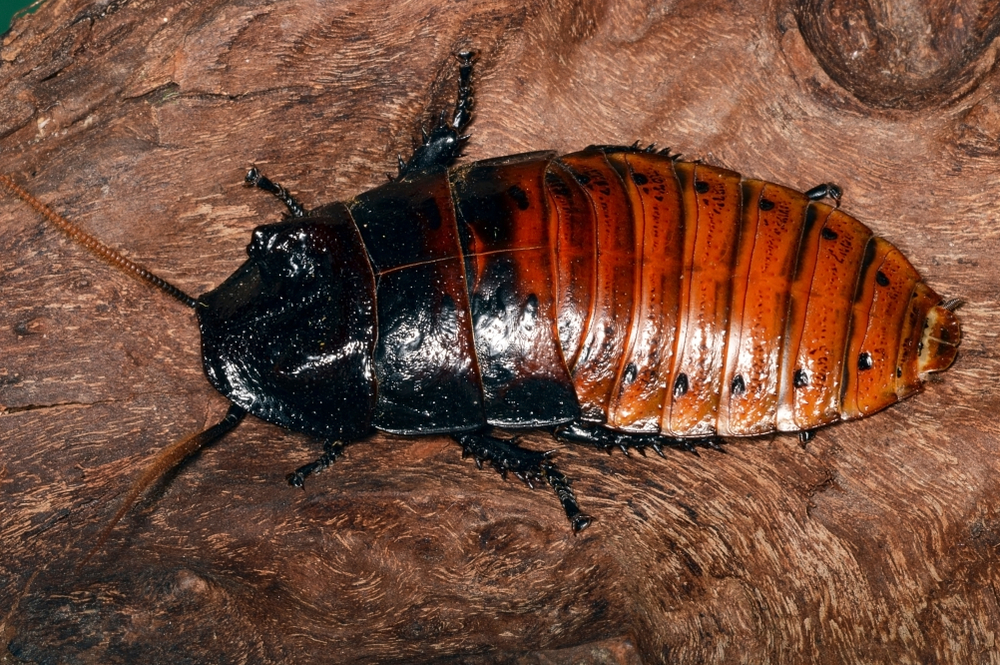Silkworm larvae, tomato hornworms, Phoenix worms, locusts, fruit flies, cock roaches--your lizards and frogs will eat them
 The dietary needs of reptiles and amphibians are often difficult to fulfill in captivity. No more than 25 years ago, only a limited number of food items were available to keepers. Today, a plethora of feeder invertebrates are on the market. This article will explore some of the newer food items that go beyond crickets and mealworms (not that there is anything wrong with the traditional insect feeders, they should be offered, too). We have used many of these insects for the past decade and are always exploring other organisms that can be used for feeding our colonies of lizards, frogs and salamanders.
The dietary needs of reptiles and amphibians are often difficult to fulfill in captivity. No more than 25 years ago, only a limited number of food items were available to keepers. Today, a plethora of feeder invertebrates are on the market. This article will explore some of the newer food items that go beyond crickets and mealworms (not that there is anything wrong with the traditional insect feeders, they should be offered, too). We have used many of these insects for the past decade and are always exploring other organisms that can be used for feeding our colonies of lizards, frogs and salamanders.

shutterstock/clement morin
No more than 25 years ago, only a limited number of food items were available to keepers. Today, a plethora of feeder invertebrates are on the market.
Silkworm larvae (Bombyx mori) and tomato hornworms (Manduca quinquemaculata) are packed with calories and nutrients. A large tomato hornworm has the mass of approximately 20 crickets. If you need to put weight on your herp, tomato hornworms are a good addition to their diet.

shutterstock/vbalson
Tomato horned worms (above) and silkworms are good dietary additions for your herps.
Silkworm larvae are not as large as tomato hornworms, but they are also an excellent source of nutrition. Both are straightforward to rear. Several companies provide these food items in an easy-to-use container complete with food for the insect. Do not feed tomato hornworms from the tomato plants in your garden. Even if you don’t use pesticides, these worms may be toxic from eating the tomato leaves. Instead, use cultured ones that have not been feeding on tomato leaves. Silkworm larvae are a little easier to rear because their preferred food item, mulberry tree leaves, is easy to acquire. “Silkworms and hornworms are nutritious, soft-bodied caterpillars that stimulate picky eaters and provide a good source of moisture to avoid dehydration. They are an easy-to-keep staple and can be helpful in rehabilitation,” said Chauntelle at Mulberry Farms, which also recommends a diet that includes a wide variety of insects.
Silkworms are the larvae of silk moths, and they have been reared by man to provide silk for clothing. These moths are entirely dependent upon humans, not existing naturally in the wild. Just like the domesticated dog; originated from the wolf, domesticated silkworms originated from wild silkworms (Bombyx mandarina) more than 5,000 years ago. They are easily raised on a diet of mulberry tree leaves. You can also find ready-made mulberry diets for these larvae on the Internet. We usually order small worms from Mulberry Farms, a company that has provided silkworms since 1997. They arrive in the mail, and we keep them at room temperature in small bins. We feed mulberry leaves harvested from local trees. The worms grow quickly and are a source of calcium and vital nutrients for our herps. They are especially helpful for replacing energy stores for our animals after egg-laying and after emerging from brumation. Depending on temperature, the silkworm larvae will metamorphose in two to three weeks.
Tomato hornworms are the larval form of a five-spotted hawkmoth, also known as a sphinx moth. They are known pests, commonly feeding upon tomato plants, but will feed on other plants, including eggplants. Using diets available online, they are easy to rear. Tomato hornworms grow fast and can provide herps with a huge amount of calories. According to one tomato hornworm provider, they make an enticing food item, especially for chameleons, because of their bright-green color. We have had many reptile species feed voraciously on this insect, including bearded dragons, collared lizards and uromastyx.
Phoenix worms are a fairly new food item that has been sold commercially for the past five years. These black soldier fly (Hermetia illucens) larvae are raised on a grain diet and reportedly have more available calcium than any other feeder. Packaged in sizes from one-eighth of an inch to three-fourths of an inch long, they are an excellent food for hatchlings and other animals. Bearded dragons, in particular, relish them. At their smallest size, they are a good food source for very small amphibians and baby lizards.
Locusts, from the family Acrididae, are great for many herp species. They are restricted for use in the United States but are readily available in Europe. Like North American grasshoppers, they are best reared in screen caging. Good ventilation is required for locusts to survive in captivity. Like crickets, they undergo incomplete metamorphosis, which means that the nymphs look like adults, without wings. Nymphs undergo five instars before they reach adulthood. Gut-loading locusts with a nutritious diet is important. The better the quality of food you feed your insects, the more nutritious they are for your herps. Start with a diet of romaine lettuce and add grated carrot and squash. Keep food items in small pieces to prevent fruit flies from invading the locust enclosures. Phoenix worms are wiggly and stimulate the appetite of finicky eaters. Their natural calcium benefits pregnant females and those who have just laid eggs. In fact, some have credited this insect with helping to reverse metabolic bone disease. This is one of numerous testimonials received by Phoenix worm producer Sheila Sheppard:”I have a veiled chameleon that was very ill with metabolic bone disease when I got him. Two vets told me that he was unlikely to survive. As soon as I started feeding him Phoenix worms, his health improved greatly. It’s amazing how much better his color and strength are. Best of all, he’s put on weight and is active and happy. My turtles love them, too”
Rachele Ottens, New Paltz, N.Y.
In the U.S., collecting and raising local grasshoppers may be help in your quest to offer your captive herps a nutritious diet. Use a sweep net to capture grasshoppers in a pesticide-free region. You can maintain your grasshoppers in screen caging. Inside each enclosure, place a 32-ounce deli cup filled with damp, not wet, sand. This gives females a place to lay their eggs. Only allow one or two grasshoppers to lay eggs in these nest boxes. Each grasshopper lays approximately 25 eggs, depending upon the species. After the grasshopper is done ovipositing, place the container’s lid back on and keep the eggs at room temperature (approximately 68 degrees). Eggs take approximately six months to hatch. Careful monitoring of moisture in the deli cup is essential. Add a little water to the container every few weeks to ensure the sand does not dry out. Too much water is equally damaging as too little water. The soil should be slightly damp for proper egg development.
Fruit flies (Drosophila spp.) are wonderful for small lizards and amphibians, such as dart frogs. Two fruit fly species are commonly available, Drosophila hydei and D. melanogaster. There are trade-offs with each species. Drosophila melanogaster reproduces more rapidly, but D. hydei is a slightly larger species. Drosophila species are easily reared, producing large numbers of offspring under proper conditions.
Drosophila are best maintained in disposable, 32-ounce plastic deli containers designed specifically for insect culture. The plastic cups can sometimes be recycled, but it is best to dispose of the ventilated lids between cultures. For ideal production, maintain an ambient temperature between 75 to 80 degrees. There are a number of recipes for various fruit fly media online, but in our experience, it is easier to purchase pre-made mixes.
Sprinkling a fine layer of baker’s yeast over the medium allows the adults to feed. Cultures are typically good for about two to three weeks, depending on use. If a large number of adult flies are allowed to accumulate, cultures will spoil more quickly. To maximize productivity, introduce between 50 to 100 adult flies when setting up fresh cultures. Most hobbyists keep cultures inside a mayonnaise jar-sized enclosure on mite paper or paper towels sprayed with a benzyl benzoate 15-percent solution. Mold is often a problem, but we have only seen it grow when contamination exists either in the flies or the rearing equipment. If mold is noticed, discard the culture entirely. This will prevent further contamination of the remaining colonies. Fruit flies are ideal feeders for species that require small food items as well as hatchlings. They reproduce quickly, and rearing supplies are inexpensive.
Cockroaches have become a popular food item for captive herps. With approximately 4,500 cockroach species in the world, this is not surprising. After overcoming our initial hesitation to rear cockroaches in our home, we were happy to see how many of our reptiles relished them as feeders.

shutterstock/guillermo guerao serra
Cockroaches have become a popular food item for captive herps. With approximately 4,500 cockroach species in the world, this is not surprising.
What’s more, they did not smell as strongly as crickets often will (even under ideal rearing conditions). The first species we worked with was the orange-headed cockroach (Eublaberus posticus). They were set up in a simple Sterilite drawer system, with wheat bran as a substrate, and fed leftover fruits and vegetables. They thrived, and we had an available food source in all seasons. We have since worked with discoid roaches (B. discoidalis), Guyana four-spot roaches (B. dubia), Turkistan roaches (Blatta lateralis), Madagascan hissing roaches (Gromphadorhina portentosa) and lobster roaches (Nauphoeta cinerea).
Lobster roaches are, without a doubt, one of the more popular feeders among our insectivorous herps. Their movements attract the attention of species that rely heavily on vision as a feeding cue. That said, they are also one of the more “accomplished” of the glass-climbing species, and it is difficult to contain them. In drier parts of the country, this does not pose a problem, as this species relies on humidity and will quickly desiccate in the typical home.
The Madagascan hissing roach, although contained more easily than lobsters, is another species that can climb glass. Many large chameleon species and juvenile monitors enjoy feeding on these large-bodied roaches. In the end, we abandoned our efforts to rear glass-climbing species, but if your space allows and you are not risking divorce or losing a roommate, both species are relished as food items.
The most commonly available, non-glass-climbing cockroaches include the Guyana four-spot roach, the discoid roach and the Turkistan roach. All are easily reared. The Guyana four-spot roach and the discoid roach are live-bearing species with fairly rapid reproduction. They grow quickly, and both become heavy-bodied adults. Unfortunately, these species are sedentary once introduced to the terrarium and will often hide and go undetected by the animals they are meant to feed. Place them in a shallow bowl, so they remain exposed and are more likely to be eaten. The Turkistan roach is oviviparous, but with a decent colony size, it can reproduce quite rapidly. Its fast movement often attracts the attention of insectivorous herps. Another benefit of this species is the small size of the nymphs. They are around one-eighth of an inch when they first hatch and can be used to feed hatchling geckos, as well as dart frogs and mantellas.
Crickets will undoubtedly remain a dietary staple for insectivorous herps, but new food items have gained in popularity. This new diversity in the world of feeder insects will contribute to greater health of captive herps. Try new feeders you may see advertised in REPTILES or that you happen across while visiting an expo – your animals will be pleasantly surprised!



